brake light YAMAHA XSR 900 2019 Owners Manual
[x] Cancel search | Manufacturer: YAMAHA, Model Year: 2019, Model line: XSR 900, Model: YAMAHA XSR 900 2019Pages: 102, PDF Size: 7.77 MB
Page 6 of 102

Table of contentsSafety information........................... 1-1
Description ....................................... 2-1
Left view ......................................... 2-1
Right view ....................................... 2-2
Controls and instruments................ 2-3
Instrument and co ntrol functions... 3-1
Immobilizer system ..... .................... 3-1
Main switch/steering lock................ 3-2
Indicator lights and warning
lights ............................................ 3-3
Multi-function meter unit ................. 3-6
D-mode (drive mode).................... 3-12
Handlebar switches ...................... 3-13
Clutch lever................................... 3-14
Shift pedal..... ............................ .... 3-15
Brake lever ................................... 3-15
Brake pedal .................................. 3-16
ABS .............................................. 3-16
Traction control syst em ................ 3-17
Fuel tank cap ................................ 3-18
Fuel............................................... 3-19
Fuel tank breather hose and overflow hose ............................ 3-21
Catalytic converter ........................ 3-21
Seat .............................................. 3-22
Storage compartment ................... 3-22
Adjusting the front fork.................. 3-23
Adjusting the shock absorber assembly ................................... 3-24 Luggage strap holders .
................ 3-26
Auxiliary DC connector................. 3-26
Sidestand ..................................... 3-27
Ignition circuit cut- off system ........ 3-27
For your safety – pre-operation
checks .............................................. 4-1
Operation and important riding
points ................................................ 5-1
Starting the engine ......................... 5-1
Shifting ........................................... 5-2
Tips for reducing fuel consumption ............................... 5-3
Engine break-in .............................. 5-3
Parking ........................................... 5-4
Periodic maintenance and
adjustment ....................................... 6-1
Tool kit............................................ 6-2
Periodic maintenance charts .......... 6-3
Periodic maintenance chart for the emission control system ............. 6-3
General maintenance and lubrication chart .......................... 6-5
Checking the spark plugs ............... 6-9
Canister ........................................ 6-10
Engine oil ..................................... 6-10
Why Yamalube ............................. 6-13
Coolant ......................................... 6-13
Air filter element ........................... 6-14 Checking the engine idling
speed............ ............................ 6-15
Checking the throttle grip free play ........................................... 6-15
Valve clearance ........................... 6-15
Tires ............................................. 6-16
Cast wheels ................................. 6-18
Adjusting the clutch lever free
play ........................................... 6-18
Checking the brake lever free play ........................................... 6-19
Brake light switches ..................... 6-20
Checking the front and rear brake pads................................ 6-20
Checking the brake fluid level ...... 6-21
Changing the brake fluid .............. 6-22
Drive chain slack.......................... 6-22
Cleaning and lubricating the drive chain ................................ 6-24
Checking and lubricating the
cables ....................................... 6-25
Checking and lubricating the throttle grip and cable ............... 6-25
Checking and lubricating the brake and shift pedals .............. 6-25
Checking and lubricating the brake and clutch levers ............ 6-26
Checking and lubricating the
sidestand .................................. 6-27
Lubricating the swingarm pivots ........................................ 6-27BAE-9-E0.book 1 ページ 2018年8月22日 水曜日 午後2時17分
Page 7 of 102

Table of contents
Checking the front fork ................. 6-27
Checking the steering ................... 6-28
Checking the wheel bearings ....... 6-28
Battery .......................................... 6-29
Replacing the fuses ...................... 6-30
Replacing the headlight bulb ........ 6-33
Replacing the auxiliary light bulb .......................................... 6-34
Brake/tail light ............................... 6-35
Replacing a turn signal light bulb ........................................... 6-35
License plate light......................... 6-36
Supporting the motor cycle............ 6-36
Troubleshooting............................ 6-36
Troubleshooting charts ................. 6-38
Motorcycle care and storage .......... 7-1
Matte color caution ......................... 7-1
Care................................................ 7-1
Storage ........................................... 7-3
Specifications .................................. 8-1
Consumer information .................... 9-1
Identification numbers .................... 9-1
Diagnostic connector ... ................... 9-2
Vehicle data recording.................... 9-2
Index ............................................... 10-1
BAE-9-E0.book 2 ページ 2018年8月22日 水曜日 午後2時17分
Page 14 of 102
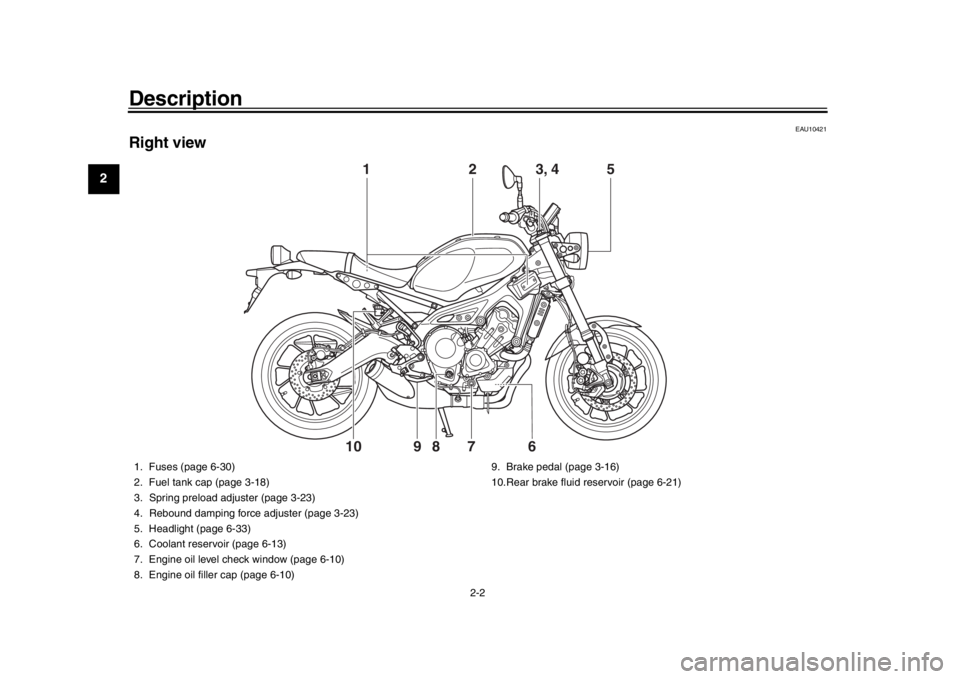
Description
2-2
12
3
4
5
6
7
8
9
10
11
12
EAU10421
Right view
2
5
8
7
9
6
10
1
3, 4
1. Fuses (page 6-30)
2. Fuel tank cap (page 3-18)
3. Spring preload adjuster (page 3-23)
4. Rebound damping force adjuster (page 3-23)
5. Headlight (page 6-33)
6. Coolant reservoir (page 6-13)
7. Engine oil level check window (page 6-10)
8. Engine oil filler cap (page 6-10) 9. Brake pedal (page 3-16)
10.Rear brake fluid reservoir (page 6-21)
BAE-9-E0.book 2 ページ 2018年8月22日 水曜日 午後2時17分
Page 19 of 102
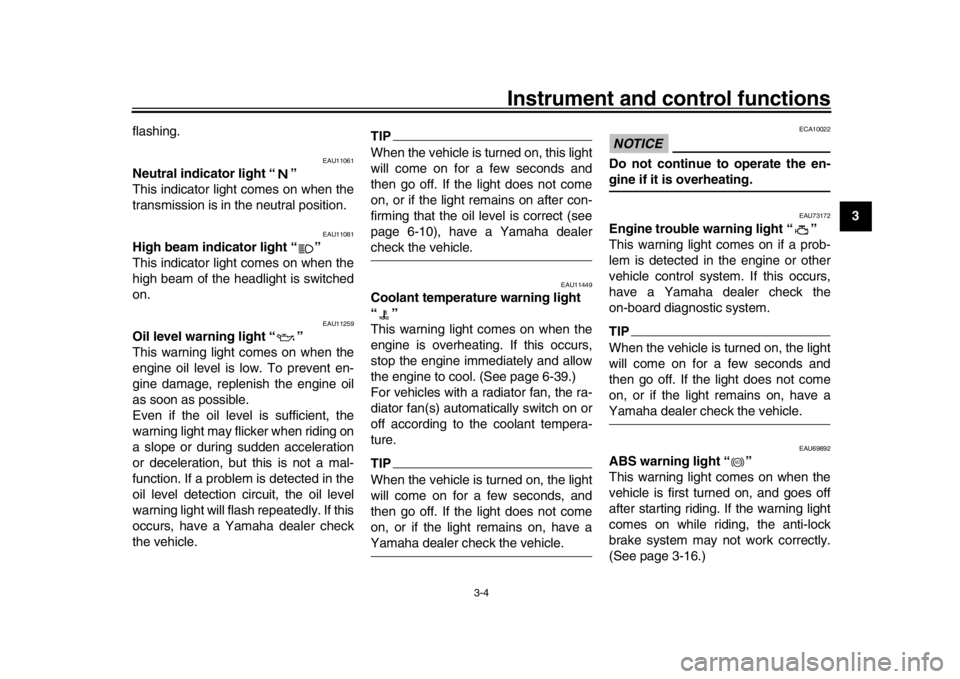
Instrument and control functions
3-4
1
234
5
6
7
8
9
10
11
12
flashing.
EAU11061
Neutral indicator light “ ”
This indicator light comes on when the
transmission is in the neutral position.
EAU11081
High beam indicator light “ ”
This indicator light comes on when the
high beam of the headlight is switched
on.
EAU11259
Oil level warning light “ ”
This warning light comes on when the
engine oil level is low. To prevent en-
gine damage, replenish the engine oil
as soon as possible.
Even if the oil level is sufficient, the
warning light may flicker when riding on
a slope or during sudden acceleration
or deceleration, but this is not a mal-
function. If a problem is detected in the
oil level detection circuit, the oil level
warning light will flash repeatedly. If this
occurs, have a Yamaha dealer check
the vehicle.
TIPWhen the vehicle is turned on, this light
will come on for a few seconds and
then go off. If the light does not come
on, or if the light remains on after con-
firming that the oil level is correct (see
page 6-10), have a Yamaha dealercheck the vehicle.
EAU11449
Coolant temperature warning light
“”
This warning light comes on when the
engine is overheating. If this occurs,
stop the engine immediately and allow
the engine to cool. (See page 6-39.)
For vehicles with a radiator fan, the ra-
diator fan(s) automatically switch on or
off according to the coolant tempera-
ture.TIPWhen the vehicle is turned on, the light
will come on for a few seconds, and
then go off. If the light does not come
on, or if the light remains on, have aYamaha dealer check the vehicle.
NOTICE
ECA10022
Do not continue to operate the en-gine if it is overheating.
EAU73172
Engine trouble warning light “ ”
This warning light comes on if a prob-
lem is detected in the engine or other
vehicle control system. If this occurs,
have a Yamaha dealer check the
on-board diagnostic system.TIPWhen the vehicle is turned on, the light
will come on for a few seconds and
then go off. If the light does not come
on, or if the light remains on, have aYamaha dealer check the vehicle.
EAU69892
ABS warning light “ ”
This warning light comes on when the
vehicle is first turned on, and goes off
after starting riding. If the warning light
comes on while riding, the anti-lock
brake system may not work correctly.
(See page 3-16.)
ABS
BAE-9-E0.book 4 ページ 2018年8月22日 水曜日 午後2時17分
Page 20 of 102
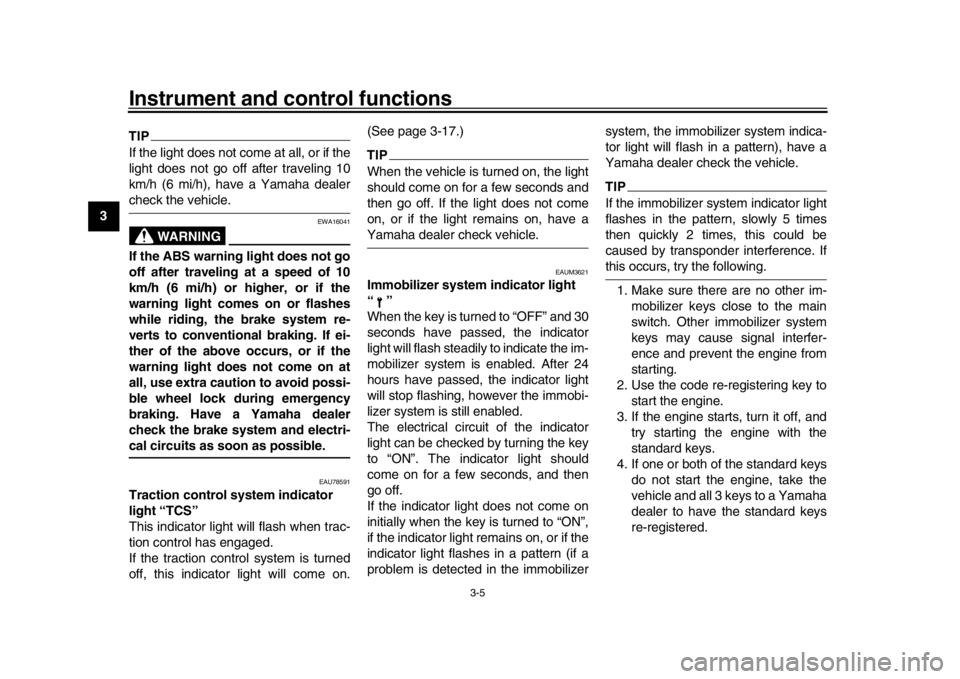
Instrument and control functions
3-5
1
23
4
5
6
7
8
9
10
11
12
TIPIf the light does not come at all, or if the
light does not go off after traveling 10
km/h (6 mi/h), have a Yamaha dealercheck the vehicle.
WARNING
EWA16041
If the ABS warning light does not go
off after traveling at a speed of 10
km/h (6 mi/h) or higher, or if the
warning light comes on or flashes
while riding, the brake system re-
verts to conventional braking. If ei-
ther of the above occurs, or if the
warning light does not come on at
all, use extra caution to avoid possi-
ble wheel lock during emergency
braking. Have a Yamaha dealer
check the brake system and electri-cal circuits as soon as possible.
EAU78591
Traction control system indicator
light “TCS”
This indicator light will flash when trac-
tion control has engaged.
If the traction control system is turned
off, this indicator light will come on. (See page 3-17.)
TIPWhen the vehicle is turned on, the light
should come on for a few seconds and
then go off. If the light does not come
on, or if the light remains on, have aYamaha dealer check vehicle.
EAUM3621
Immobilizer system indicator light
“”
When the key is turned to “OFF” and 30
seconds have passed, the indicator
light will flash steadil
y to indicate the im-
mobilizer system is enabled. After 24
hours have passed, the indicator light
will stop flashing, however the immobi-
lizer system is still enabled.
The electrical circuit of the indicator
light can be checked by turning the key
to “ON”. The indicator light should
come on for a few seconds, and then
go off.
If the indicator light does not come on
initially when the key is turned to “ON”,
if the indicator light remains on, or if the
indicator light flashes in a pattern (if a
problem is detected in the immobilizer system, the immobilizer system indica-
tor light will flash in a pattern), have a
Yamaha dealer check the vehicle.
TIPIf the immobilizer system indicator light
flashes in the pattern, slowly 5 times
then quickly 2 times, this could be
caused by transponder interference. Ifthis occurs, try the following.
1. Make sure there are no other im- mobilizer keys close to the main
switch. Other immobilizer system
keys may cause signal interfer-
ence and prevent the engine from
starting.
2. Use the code re-registering key to start the engine.
3. If the engine starts, turn it off, and try starting the engine with the
standard keys.
4. If one or both of the standard keys do not start the engine, take the
vehicle and all 3 keys to a Yamaha
dealer to have the standard keys
re-registered.
BAE-9-E0.book 5 ページ 2018年8月22日 水曜日 午後2時17分
Page 30 of 102
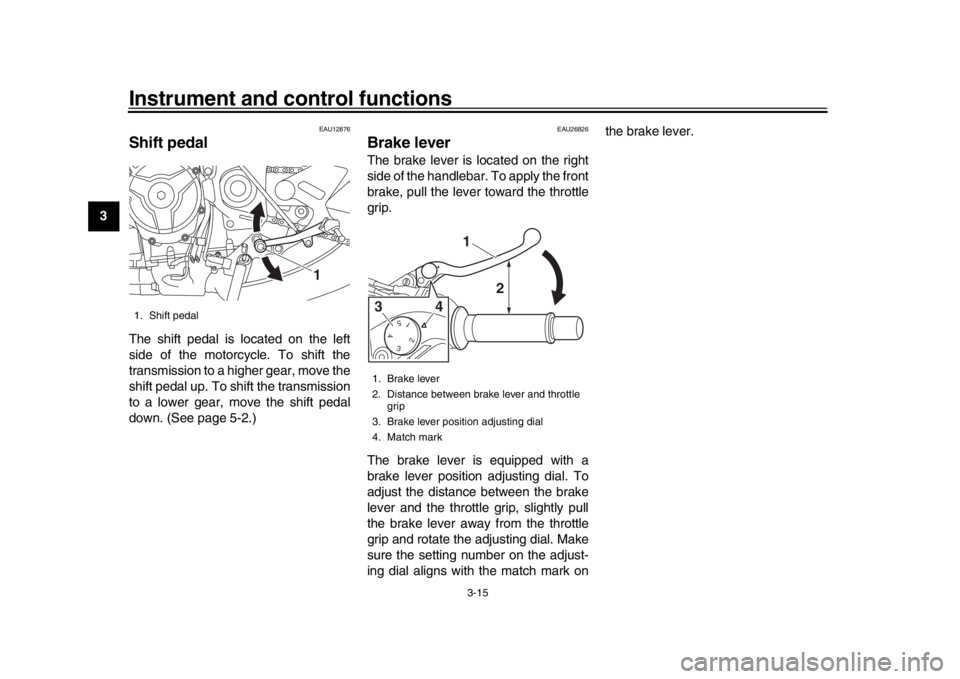
Instrument and control functions
3-15
1
23
4
5
6
7
8
9
10
11
12
EAU12876
Shift pedalThe shift pedal is located on the left
side of the motorcycle. To shift the
transmission to a higher gear, move the
shift pedal up. To shift the transmission
to a lower gear, move the shift pedal
down. (See page 5-2.)
EAU26826
Brake leverThe brake lever is located on the right
side of the handlebar. To apply the front
brake, pull the lever toward the throttle
grip.
The brake lever is equipped with a
brake lever position adjusting dial. To
adjust the distance between the brake
lever and the throttle grip, slightly pull
the brake lever away from the throttle
grip and rotate the adjusting dial. Make
sure the setting number on the adjust-
ing dial aligns with the match mark on the brake lever.
1. Shift pedal
1
1. Brake lever
2. Distance between brake lever and throttle
grip
3. Brake lever position adjusting dial
4. Match mark
5 4 3 2 1
1
2
4
3
BAE-9-E0.book 15 ページ 2018年8月22日 水曜日 午後2時17分
Page 31 of 102
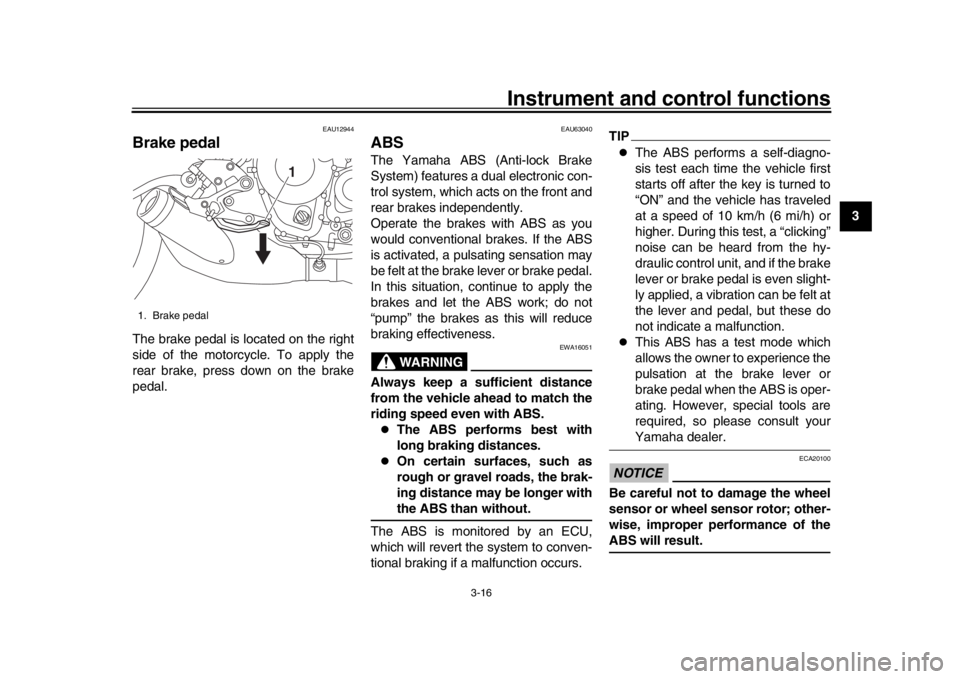
Instrument and control functions
3-16
1
234
5
6
7
8
9
10
11
12
EAU12944
Brake pedalThe brake pedal is located on the right
side of the motorcycle. To apply the
rear brake, press down on the brake
pedal.
EAU63040
ABSThe Yamaha ABS (Anti-lock Brake
System) features a dual electronic con-
trol system, which acts on the front and
rear brakes independently.
Operate the brakes with ABS as you
would conventional br akes. If the ABS
is activated, a pulsating sensation may
be felt at the brake lever or brake pedal.
In this situation, continue to apply the
brakes and let the ABS work; do not
“pump” the brakes as this will reduce
braking effectiveness.
WARNING
EWA16051
Always keep a sufficient distance
from the vehicle ahead to match the
riding speed even with ABS.
The ABS performs best with
long braking distances.
On certain surfaces, such as
rough or gravel roads, the brak-
ing distance may be longer withthe ABS than without.
The ABS is monitored by an ECU,
which will revert the system to conven-
tional braking if a malfunction occurs.
TIP
The ABS performs a self-diagno-
sis test each time the vehicle first
starts off after the key is turned to
“ON” and the vehicle has traveled
at a speed of 10 km/h (6 mi/h) or
higher. During this test, a “clicking”
noise can be heard from the hy-
draulic control unit, and if the brake
lever or brake pedal is even slight-
ly applied, a vibration can be felt at
the lever and pedal, but these do
not indicate a malfunction.
This ABS has a test mode which
allows the owner to experience the
pulsation at the brake lever or
brake pedal when the ABS is oper-
ating. However, special tools are
required, so please consult yourYamaha dealer.
NOTICE
ECA20100
Be careful not to damage the wheel
sensor or wheel sensor rotor; other-
wise, improper performance of theABS will result.
1. Brake pedal
1
BAE-9-E0.book 16 ページ 2018年8月22日 水曜日 午後2時17分
Page 57 of 102

Periodic maintenance and adjustment
6-7
1
2
3
4
567
8
9
10
11
12
23 *Rear suspension
relay arm and
connecting arm
pivoting points Check operation.
24 Engine oil Change (warm engine before
draining).
Check oil level and vehicle for oil leakage.
25 Engine oil filter
cartridge Replace.
26 *Cooling system Check coolant level and vehicle
for coolant leakage.
Change. Every 3 years
27 *Front and rear brake
switches Check operation.
28 *Moving parts and
cables Lubricate.
29 *Throttle grip
housing and cable Check operation and free play.
Adjust the throttle cable free play
if necessary.
Lubricate the throttle grip housing and cable.
30 *Lights, signals and
switches Check operation.
Adjust headlight beam.
NO. ITEM CHECK OR MAINTENANCE JOB
ODOMETER READING
ANNUAL
CHECK
1000 km
(600 mi) 10000 km
(6000 mi) 20000 km
(12000 mi) 30000 km
(18000 mi) 40000 km
(24000 mi)
BAE-9-E0.book 7 ページ 2018年8月22日 水曜日 午後2時17分
Page 70 of 102
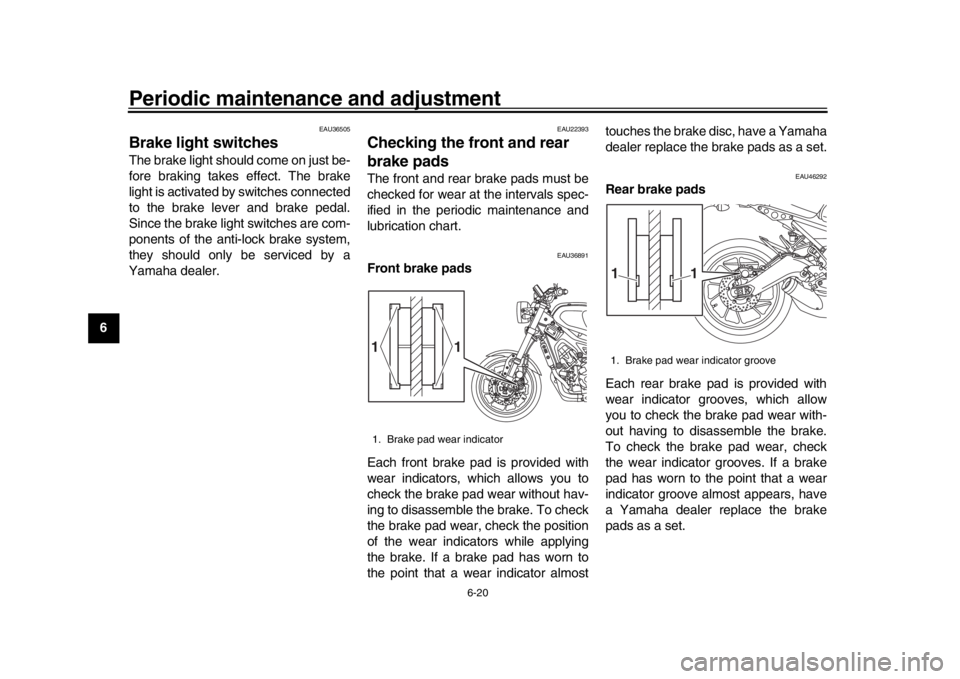
Periodic maintenance and adjustment
6-20
1
2
3
4
56
7
8
9
10
11
12
EAU36505
Brake light switchesThe brake light should come on just be-
fore braking takes effect. The brake
light is activated by switches connected
to the brake lever and brake pedal.
Since the brake light switches are com-
ponents of the anti-lock brake system,
they should only be serviced by a
Yamaha dealer.
EAU22393
Checking the front and rear
brake padsThe front and rear brake pads must be
checked for wear at the intervals spec-
ified in the periodic maintenance and
lubrication chart.
EAU36891
Front brake pads
Each front brake pad is provided with
wear indicators, which allows you to
check the brake pad wear without hav-
ing to disassemble the brake. To check
the brake pad wear, check the position
of the wear indicators while applying
the brake. If a brake pad has worn to
the point that a wear indicator almost touches the brake disc, have a Yamaha
dealer replace the brake pads as a set.
EAU46292
Rear brake pads
Each rear brake pad is provided with
wear indicator grooves, which allow
you to check the brake pad wear with-
out having to disassemble the brake.
To check the brake pad wear, check
the wear indicator grooves. If a brake
pad has worn to the point that a wear
indicator groove almost appears, have
a Yamaha dealer replace the brake
pads as a set.
1. Brake pad wear indicator
1
1
1. Brake pad wear indicator groove
1
1
BAE-9-E0.book 20 ページ 2018年8月22日 水曜日 午後2時17分
Page 85 of 102
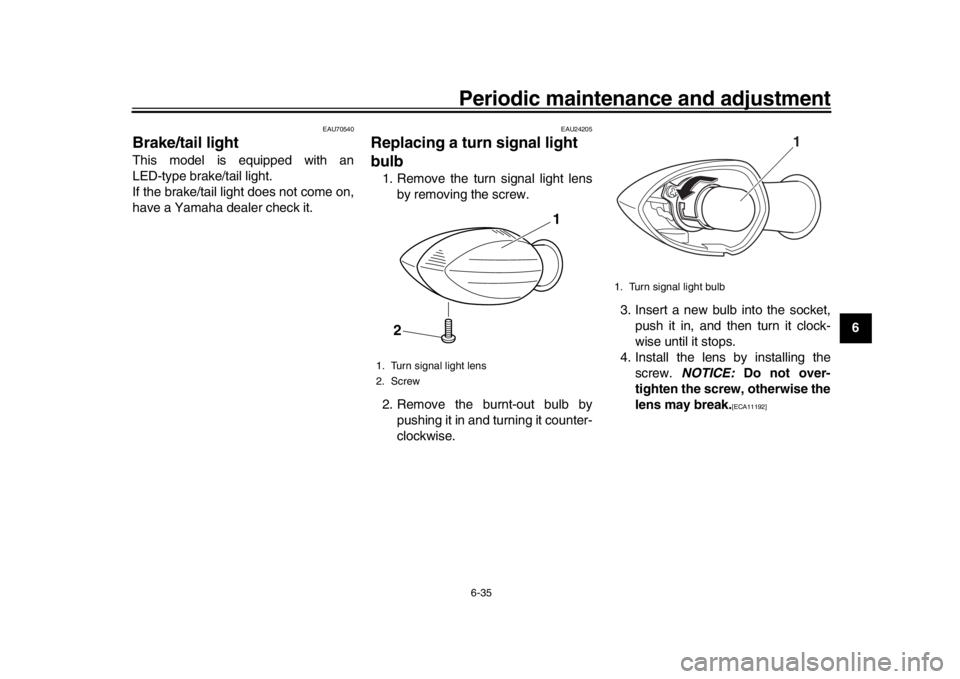
Periodic maintenance and adjustment6-35
1
2
3
4
567
8
9
10
11
12
EAU70540
Brake/tail lightThis model is equipped with an
LED-type brake/tail light.
If the brake/tail light does not come on,
have a Yamaha dealer check it.
EAU24205
Replacing a turn signal light
bulb1. Remove the turn signal light lens by removing the screw.
2. Remove the burnt-out bulb by pushing it in and turning it counter-
clockwise. 3. Insert a new bulb into the socket,
push it in, and then turn it clock-
wise until it stops.
4. Install the lens by installing the screw. NOTICE: Do not over-
tighten the screw, otherwise the
lens may break.
[ECA11192]
1. Turn signal light lens
2. Screw
1
2
1. Turn signal light bulb
1
BAE-9-E0.book 35 ページ 2018年8月22日 水曜日 午後2時17分